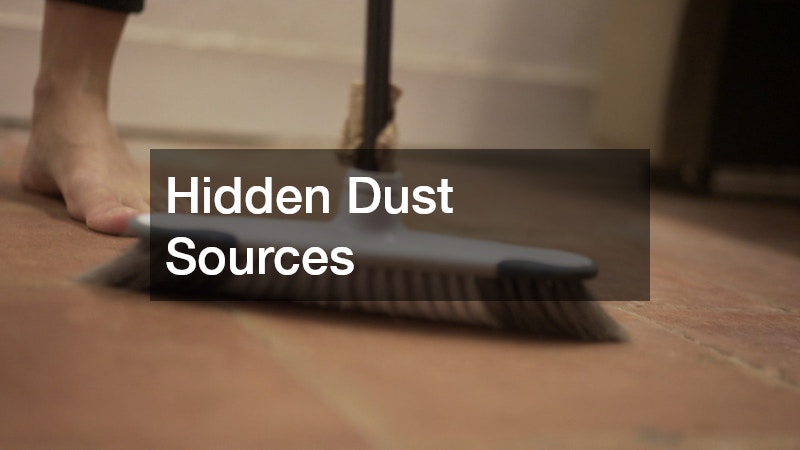No matter how much time you spend cleaning, it can feel like dust magically returns the moment you finish. That thin layer on shelves, the particles floating in the sunlight, and the unexplained buildup on furniture can be frustrating. Dust isn’t just an aesthetic problem—it can affect your health, aggravate allergies, and make your home feel less comfortable.
Understanding why your home is always dusty is the first step toward keeping it under control. Dust accumulates from multiple sources, both visible and hidden, and often in ways homeowners don’t realize. From flooring choices and HVAC systems to pets and seasonal changes, many factors contribute to dust accumulation. Here’s an in-depth look at why your home might always feel dusty and what you can do to fix it.
Dust is more than just an annoyance; it is composed of microscopic particles that can affect indoor air quality. These particles are so small that they can easily become airborne and settle in areas you rarely see. By understanding the sources of dust and how it moves throughout your home, you can take practical steps to reduce it and create a healthier, cleaner living environment.
Hidden Dust Sources

Most people assume dust comes from dirt on floors and surfaces, but it is much more complex. Dust is a mixture of tiny particles: skin cells, fabric fibers, pollen, pet dander, soil, and microscopic debris from outside. Many of these particles are lightweight and easily airborne, so they settle slowly on furniture, shelves, and flooring.
A significant contributor is your home’s heating and cooling system. Air circulating through ductwork spreads dust throughout your home, especially if air filters aren’t cleaned or replaced regularly. Partnering with a heating and cooling company ensures your air conditioning equipment is maintained, ducts are inspected, and filters are effective at trapping dust before it spreads. Homes with older HVAC systems are particularly prone to dust circulation, as outdated units often fail to filter the air adequately.
Another hidden source is your basement or crawlspace. Moisture, dirt, and even construction debris can creep upward into living spaces, leaving a subtle layer of dust behind. Investing in professional basement repair not only protects against water damage but also seals the area to prevent dust and debris from entering your home. Even simple steps like moving storage off the floor or adding floor mats in unfinished areas can help reduce dust accumulation.
Flooring and Carpets
Flooring is one of the most obvious yet overlooked contributors to dust. Carpets are notorious for trapping dirt, hair, and fibers, all of which eventually become airborne. While vacuuming is essential, it rarely removes embedded dust completely. Professional carpet cleaning can extract these deeper particles, making your home noticeably cleaner. High-traffic areas, entryways, and rooms with pets accumulate dust faster, so scheduling regular professional cleaning is a worthwhile investment.
Hardwood, tile, and laminate floors aren’t immune. Dust can settle into cracks, grout lines, and along baseboards. Frequent sweeping, vacuuming, or mopping helps, but some floors need specialized care. Using appropriate cleaning solutions and soft brushes prevents scratches while effectively removing dust. Professional floor cleaning services can extend the life of your floors and prevent fine dust particles from circulating.
Furniture placement also plays a role. Pieces that sit directly on the floor or have deep crevices collect dust that is hard to reach. Selecting furniture with smooth surfaces and minimal intricate detailing—available at most furniture stores—reduces dust accumulation and makes cleaning easier. Rotating rugs and periodically moving furniture allows you to clean hidden areas, ensuring dust doesn’t resurface quickly.
Windows and Doors

Windows are not just sources of light—they’re entry points for dust. Gaps or poorly sealed replacement windows allow particles from outside to enter, especially on windy days. Dust can also come in through sliding doors, poorly sealed garage doors, or screens. Keeping windows and doors properly sealed and cleaned is essential to prevent outdoor dust from contaminating indoor spaces.
Seasonal pollen and city pollution exacerbate this problem. In spring and summer, pollen can drift indoors, while urban dust can be significant year-round. Installing weatherstripping and using high-quality window seals can make a noticeable difference. Wiping down window sills, door frames, and screens regularly removes the dust before it has a chance to settle elsewhere.
Doormats and a no-shoes policy inside the home are additional preventative measures. By reducing the amount of dirt tracked inside, you minimize one of the primary ways dust enters through doors. These small adjustments, combined with proper window and door maintenance, contribute to a cleaner home with noticeably less dust buildup.
Hidden Air Pathways
Dust can infiltrate homes through hidden pathways that are easy to overlook. Air vents, ceiling fans, electrical outlets, and even small cracks in walls or ceilings can allow dust to move through the house. Air pressure differences often draw dust from these spaces into living areas, making regular cleaning less effective. Consulting electricians to inspect hidden wiring or outlets can prevent dust from being pulled through these gaps.
Proper ductwork maintenance is also critical. Ducts that are dirty or poorly sealed spread dust far more efficiently than clean, well-maintained systems. Professional inspection and cleaning ensure that dust is captured before it circulates. Even simple steps like sealing gaps, cleaning vent covers, and regularly replacing HVAC filters can reduce the volume of airborne dust significantly.
Ceiling fans and ventilation systems play a dual role. While they help circulate air, they also stir up dust if not cleaned frequently. Cleaning fan blades, vents, and registers regularly ensures that these circulation systems improve air quality instead of spreading dust throughout your home.
Pets and People

Pets are a major source of indoor dust, carrying dander, hair, and outdoor debris into your home. Even small breeds shed fur that clings to carpets, furniture, and bedding. Similarly, people track in particles from outside, including pollen, dirt, and fabric fibers. These invisible contributors can create the constant dust layer that makes your home feel perpetually dirty.
Regular grooming, including bathing and brushing pets, is essential to minimize shedding. Using washable covers on furniture and bedding also helps contain dust. Daily habits, like removing shoes at the door and laundering high-contact textiles frequently, prevent these tiny particles from accumulating.
The combination of pets and humans significantly increases dust production. Even with a strict cleaning routine, small airborne particles are constantly being introduced. By addressing both sources consistently, you can drastically reduce the dust in your home, improving comfort and air quality.
Seasonal and Environmental Factors
Dust levels fluctuate with the seasons. Spring and summer bring pollen and airborne allergens, while winter’s closed windows and heating systems trap dust indoors. Homes near construction zones, busy roads, or industrial areas experience higher dust levels regardless of the season. Even small seasonal shifts, like increased humidity in summer or dry indoor air in winter, can change how dust settles on surfaces and how often you need to clean.
Adjusting your cleaning schedule to match seasonal changes is vital. Using a HEPA filter, swapping HVAC filters seasonally, and scheduling deep cleaning during peak dust months can drastically reduce accumulation. Air purifiers in high-use rooms, like bedrooms and living areas, also help trap airborne particles before they settle. Combining these strategies with targeted cleaning of high-traffic areas ensures that dust does not accumulate faster than you can manage it.
Environmental factors like wind, rainfall, and urban pollution also affect dust levels. Homes surrounded by dirt roads, trees, or nearby construction are more prone to dust entry. By monitoring local environmental conditions and adjusting ventilation, window usage, and cleaning schedules, homeowners can significantly reduce indoor dust. Understanding these environmental influences allows you to anticipate dust spikes and plan preventive measures, keeping your home cleaner year-round.
Moisture and Humidity

Humidity affects dust in subtle but important ways. High humidity causes dust to settle more quickly, making surfaces appear dirtier, while extremely dry air allows dust to remain airborne longer, exacerbating allergies. Balancing humidity levels using a combination of HVAC systems, dehumidifiers, or humidifiers helps manage dust effectively.
Moisture problems in basements, crawl spaces, or walls can worsen dust issues and encourage mold growth. Professional basement repair ensures that moisture is managed, preventing the accumulation of dust and other particles. Even small leaks in plumbing or roof systems contribute to increased dust if not addressed.
Maintaining optimal indoor humidity levels between 40–50% reduces airborne dust while preventing mold and mildew growth. Using hygrometers to monitor humidity and making adjustments seasonally helps maintain both air quality and surface cleanliness.
Pest Activity
Dust can also originate from unexpected sources such as insects and rodents. Pests leave droppings, shed skins, and nesting materials that contribute fine dust particles throughout the home. Professional pest control services identify infestations early and implement solutions to prevent dust from pests accumulating further.
Even minor infestations can have a large impact on dust accumulation. For instance, cockroaches shed tiny skin particles daily, which mix with household dust. Mice or rats leave droppings and fur that further contribute to indoor dust.
Preventative measures like sealing gaps, storing food properly, and regular inspections are essential. By combining proactive prevention with professional interventions, homeowners can stop pests from becoming a major source of dust.
Cleaning Techniques That Work
Even with preventive measures, regular cleaning is essential. Using HEPA-filter vacuums, microfiber cloths, and gentle cleaning solutions can remove fine dust particles effectively. Rotating cleaning tools and following a top-to-bottom approach ensures that dust isn’t redistributed.
Professional house cleaning services provide a deeper clean than routine daily efforts. They can reach areas that are often missed, including ceiling corners, light fixtures, behind appliances, and inside air vents. Scheduling professional cleanings periodically complements daily cleaning efforts, keeping dust levels consistently low.
Creating a systematic routine makes cleaning more effective. Vacuum before dusting, work from top to bottom, and focus on high-traffic areas first. Even small habits like changing bedding weekly and wiping electronics frequently prevent dust buildup over time.
Air Circulation and Filtration
Proper air circulation prevents dust from settling in stagnant areas. Regular maintenance of air conditioning equipment, combined with filter replacements and duct cleaning, improves indoor air quality and minimizes airborne dust. Using fans or standalone air purifiers in problem rooms can further reduce particles.
Understanding airflow patterns helps optimize cleaning and reduce dust accumulation. For example, directing airflow from clean areas toward high-traffic zones ensures dust is carried away rather than redistributed.
Standalone HEPA purifiers or upgraded HVAC filters are particularly effective in bedrooms and living rooms. By combining circulation improvements with filtration, homeowners can drastically reduce indoor dust levels and create a cleaner, healthier living environment.
Maintenance Matters
Routine maintenance addresses the root causes of dust in the home. This includes inspections by chimney cleaners to remove soot and ash, checking replacement windows for drafts, sealing vents, and performing basement repair as needed. Electrical inspections by electricians ensure outlets and wiring don’t contribute to dust buildup.
Regular maintenance also prevents long-term dust accumulation in areas that are hard to clean. For instance, cleaning vents, sealing ducts, and maintaining windows reduces dust entry from outside. Small problems that are left unaddressed, like a cracked vent cover or a leaky chimney, can multiply over time, creating significant dust problems.
Investing in preventative maintenance ensures your home stays dust-free longer. Even simple tasks like inspecting HVAC filters, sealing cracks, and scheduling routine pest inspections by pest control professionals can reduce the workload of day-to-day cleaning and maintain a consistently cleaner environment.
A house that is always dusty is rarely caused by one single factor. Flooring, furniture, ventilation systems, pets, seasonal changes, environmental factors, and hidden maintenance issues all contribute. Addressing these sources with professional help—such as carpet cleaning, chimney cleaner services, house cleaning, and heating and cooling company maintenance—significantly reduces dust accumulation.
Daily habits, like selecting easy-to-clean furniture from furniture stores, maintaining air conditioning equipment, and using pest control, further help keep dust levels low. By combining regular cleaning with ongoing maintenance and professional assistance, you can finally enjoy a home that feels fresh, clean, and dust-free—even after hours of cleaning.
With consistent attention to both prevention and cleaning, dust can be managed effectively, creating a healthier, more comfortable home environment for you and your family.


